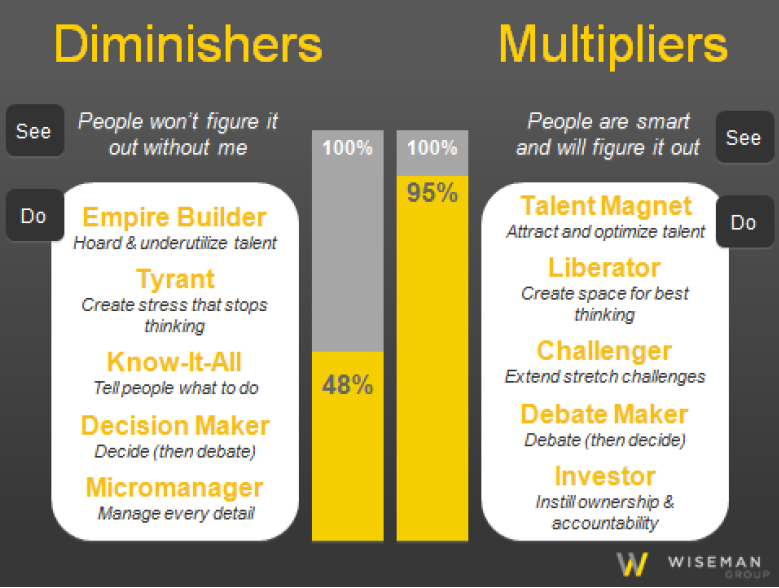
Who is the best manager: Frank or George?
Source: "Multipliers: How the Best Leaders Make Everyone Smarter"
Manager #1: Frank
Consider two division managers at Intel. Both worked in the same company, in the same job and with many of the same people. But these two leaders had a markedly different impact on these people. The first was "Frank," who had been promoted into management after architecting one of the early microprocessor chips. Frank was a brilliant scientist, but the problem was that he did all the thinking for his team.
Vikram, who was one of his management team members, said, "He was very, very smart. But people had a way of shutting down around him. He just killed our ideas. You always knew he would have an answer for everything." In a typical team meeting, he did about 30 percent of the talking and left little space for others. He had really strong opinions and put his energy into selling his ideas to others and convincing them to execute on the details.
Frank hired intelligent people, but they soon realized that they didn't have permission to think for themselves and would either quit or threaten to quit. Vikram reflected, "My job was more like cranking than creating. Frank really only got from me about 50 percent of what I had to offer."
Manager #2: George
Vikram worked for another divisional manager at Intel, George, who managed to get everything out of him. George had a reputation for running successful businesses at Intel, and every business he ran was profitable and grew under his leadership. Vikram said, "I was a rock star around George. He made me and my career. Around him I felt like a smart SOB -- everyone felt like that. He got 100 percent from me - it was exhilarating."
George grew people's intelligence by engaging it. He wasn't the center of attention and didn't worry about how smart he looked. In a typical team meeting, he spoke only about 10 percent of the time, mostly just to "crisp up" the problem statement. He would then back away and give his team space to find an answer. Often the ideas his team would generate were worth incremental millions to the business.
Frank was so absorbed in his own intelligence that he stifled others and diluted the organization of crucial intelligence and capability.
George brought out the intelligence in others and created collective, viral intelligence in his organization. He made use of all the brainpower that sat in his organization.
One leader was a genius. The other was a genius maker.
"Are you a genius or a genius maker? We've all had experience with two dramatically different types of leaders. The first type drains intelligence, energy, and capability from the people around them and always needs to be the smartest person in the room. These are the idea killers, the energy sappers, the diminishers of talent and commitment. On the other side of the spectrum are leaders who use their intelligence to amplify the smarts and capabilities of the people around them. When these leaders walk into a room, light bulbs go off over people's heads; ideas flow and problems get solved. These are the leaders who inspire employees to stretch themselves and get more from other people. These are the Multipliers."

Senior Executive Advisor, Executive Services. IT Security SME, Marketing Strategy SME.
5yGreat article Robert and so true ! How can I tell you live what you been taught as so many former IBMers. I'm going to use some messaging from this article. Take care !
Data Scientist and Master Inventor at IBM
5yIdeally, I'd like to be a genius maker who also happens to be a genius ;-)